
DOI:10.55559/sjahss.v1i03.37 | Received: 14.03.2022 | Accepted: 20.03.2022 | Published: 31.03.2022
ABSTRACT
Afghan contemporary women painters relying on the foundations of modernism and the legacy of visual tradition have found a great presence in contemporary art in this country. In this regard, these painters have created artworks in political and social contexts, women's issues, portraiture, inanimate nature, and figures. The question is how Afghan contemporary women's painters have used the rich country's assets in their contemporary painting? And what are their attitudes to this old treasure? This paper provides results using a descriptive-analytical method and using the library and archive resources. First, not only the attitude towards the past and the visual capital of painting, both for men and Afghan contemporary women's painters, are not reactionary, but it is also wealth for their contemporary works; it has been promoted visually. It was also found that the functions of painting in the works of these female painters can be seen in the application of elements such as colour (coordination), golden colour, divergence or use frame failure by plant images, the combination of plant designs, geometric, illumination or divination, and Calligraphy with painting, as well as the combination of naturalist painting with plant designs, as well as combining elements such as Simorgh, Islamic architectural designs, or flowers and chicken with oil paintings. It was also found that two types of socio-political approaches to expressing women's concerns and issues and paying attention to painting to revitalize the heritage of this land have attracted the most attention of the Afghan contemporary women painters.
keywords: Contemporary Afghan Painting, Miniature, Afghan Painting, Women painters
Introduction
Afghanistan is a mentally and culturally important country in the Islamic World. It has been the origin of so many historical, religious, and mythical glories. For example, Pishdadian and Kayanian - including Jamshid, Fereydoun, Kay Kavus, Kay Kobad and Kay Khosrow - rose from Afghanistan. (Kahzad, 1355, V1: 317) On the other side, Afghan people are closer to Iranian people than other countries; thus, their cultures are the same, but they also share the essential parts of history. (Tafazoli, 1354: 8) The two countries are deeply connected. Also, Molana Rumi has met Afghanistan according to his poem: "I can express myself better than a nightingale, but the jealousness of people makes me close my mouth and wish for an Afghan". (Afshar, 1356: 515) At this point, one of the civilized backgrounds of Afghanistan, in common with other Islamic countries, is studying the contemporary art, esp. the contemporary painting of this country, thanks to the rich visual references left from the artists before and after Islam, mainly Herat school – which are a part of the Islamic word's visual art glories. According to historic resources, males were more present than females in this country's art, but this is not the case in this study. With due attention to the rich visual references of this country and the arrival of modernism and its effect on their art, we can see that women have participated in contemporary painting more than before.
The question is how female artists have faced this artistic inheritance that soared in Herat school? How has painting affected women's early artworks in Afghanistan? This article was written by a descriptive-analytic method using the library and archived references. Utilizing articles from Dr Mahmoud Afshar in Gohar Magazine, Jahangir Tafazoli in Yaghma Magazine, etc. about Afghanistan's History; the books: "Babarname", "Habib Assir fi Akhbari Afrad w Bashar", and "Afghanistan History" about Afghanistan's Art; the books: "Abdul Hay Habibi", "Yazdan Ali Mardanof, etc. about Timurid Art; the book: "Along Art" written by Faramarz Sarvari which includes some of the artworks; and Afghanistan's paintings biennials archives.
Women's presence in Afghan art periods
Due to several reasons, such as civil wars, extremist oppositions, etc., there are few references about Afghan art and women's presence. Yet, we can count four periods in Afghan art.
- Before Islam:
Most of the antiques achieved from Afghan archaeology relate to Achaemenid's coin designs, cylindrical pieces and ceramics. Researchers believe that the antiques discovered from the Eynak copper mine, excavations of Kabul's Kheir Khane and other cities like Bamian, Ghazni and Herat, indicate the local men's expert knowledge in sculpture and Painting. (Brishna, 1333: 15) Some evidence shows the existence of sculpting and Painting in Oxus beach (Amu Darya), which Prof. Hartsfield believes to be the origin of the Buddhist industry, central fine art and the industry of Parthian, Kushani and Sassanian periods. Also, there are many paintings of women in Bamian stores and stories about paintings of the prophet Mani, who took Khurasan's art to China, Turkestan and middle Asian countries. On the way back, his art was affected by Chinese art, whereas he had followers in China and Turkestan. (Same: 19) Rahimi says, quoting Pope: "From 5 BC till 8 AD, Aryan and Khurasan's painting has impressed Chinese Painting for 13 centuries. But nowadays, there are not so many pieces of paintings left from the before Islam period in Afghanistan except the discovered ancient resources and the frescoes of men and women in Bamian stores. (Rahimi, 1389: 5)
- The first golden period:
This period goes back to after Islam period and Herat school. After the Mongol conquest, two things got more important in Afghanistan: fine art and writing history in Persian. Afghans grabbed these two subjects because Iranians had witnessed that Timur paid more attention to these issues. After Sultan Husain Bayqara came to power in Herat and with the help of Amir Ali Shir Navaie, who were both interested in literature and fine art, a perfect school arose. This school became so popular and superb that many artisans from all around the country joined it and made literature and fine art more splendid which continued in the Safavid dynasty. (Khandmir, 1380, V1: 3-4) According to what Khandmir says in his books, during the governorship of Sultan Hussain: "There were many artists, scientists and philosophers are living in Herat and other provinces, and Herat was developed and enlarged as the centre of civilization, calligraphy and inscription. This development lets Shahrukh Mirza gather artists and artisans from Khurasan and other provinces in Herat even after the Timurid empire." (Mardanof, 1387:47) Zuhriddin Babur Mirza considers the civilization of Herat very unique and believes that Herat people are diligent in their profession and perfectly accomplish their responsibilities. (Babur Mirza, 1958: 177) Baysunghur wrote poems in Tajik, Farsi, Arabic and Turkish. He was talented in Painting and knew six kinds of Arabic calligraphy. He established a library in Herat and gathered 40 people, including painters, calligraphers, scribes and artists for inscription. (Khandmir, 1380, V3: 622) Shahrukh built a library full of handwritten books as well. Behzad, the extraordinary Afghan painter, grew under these circumstances. As a result of these people's attention: Shahrukh, Abu Saeed, Sultan Hussain Bayqara, Baysunghur, Ibrahim, Mumin and Muzaffar Husain, Herat art school was the centre of artistic developments for one century – from 810 AH to 912 AH. But after Sultan Hussain Baysunghur's death, the Uzbek invasion from the north and the Safavid invasion from the west, the Timurid well-known art school – Herat, went down. After that, artists helplessly went to India, Bukhara and Iran and maintained Herat school in those countries. (Habibi, Bita, 558) In this period, we can say about women's presence in paintings that figures in Behzad's paintings (male/female) presented "the complete human" and his valuable qualities. (Ebrahimi Naghani, 1382: 98) Also illustrating, Shahnameh permitted artists to show women's presence bolder than before. The woman is present all over Shahnameh, but unlike Iliad, she is not causing any wars. (Motghi, 1388: 74)
- The second golden period:
This period relates to Amir Amanullah Khan's governorship in 1300 SH. In these years, Prof. Gholam Mohammad Meymangi established the first arts and industries school in Kabul with the help of Fayz Mohammad Khan (Ministry of Education), Shah Amanullah Khan and the German government. (Kashkaki, 1303: 34) Abdul Qafur Brishna started teaching in this school. In 1351, after a transformation from imperial to republic governorship, the ministry of intelligence and culture established the second art centre called "Fine Arts", which was renamed as "Meymangi Gallery" afterwards (rafiei rad & et al.,2021: 27-30).
President Mohammad Davudkhan's endorsement, the Faculty of Fine Arts of Kabul University, was established in 1345. Amanullah Heydar Zadeh was the founder, and after a year, Hamed Navid joined him. The permanence knows the second golden period of realism in Herat school. Because most of the artworks from this period, left by artists like Brishna, have instead focused on pragmatic receptions from nature, old alleys, muddy houses and people's lifestyles. Academic thoughts and accepting naturalistic standards was also commenced in this period. (Omarzade, 1397: 15)
After the Saur Revolution in 1357, Afghanistan's art became stagnant and used for socialistic purposes. At this time, there were not so many artworks from the artists such as Simon Shakurvali, Amanullah Parsa, Sayed Moghadas Negah, Israel Roya, Yusuf Kahzad, Shabnam Qaznavi, etc. to be considered as an insurrection in Afghan Painting. (Same) The Soviet-Afghan War destroyed art, culture and education centres. After the war ended in 1375, the Taliban banned teaching art in schools. Sculpting, music, photography, cinema and Painting actual figures were forbidden. (Rafiei Rad & Tumiris, 1396: 20)
- The last two decades, modernism:
After the Taliban was defeated, Hamid Karzai became the president from 2001 to 2014. Researchers believe Karzai's government improved Afghanistan's art. Even though foreigners' job opportunities and orders burgeoned Afghan Painting in this period, it banished artists from Iranian Painting (because there were no orders). Artists were paying more attention to the tradable aspects of the artworks. (rafiei rad & et al: 102)
New opportunities have arisen for women to participate in Afghanistan's Art during the last twenty years. Establishing the first contemporary arts centre in 1383 was an essential step along with this issue. "Creativity, the power of thinking, modernism and freedom of speech are more emphasized after this event. Women being pioneers is one of the qualities of this period." (Omarzade, 1397: 16) Critical, political and social subjects were bolder than before, and the artistic borders were less important.
The concepts of contemporary painting in Afghanistan's female painter's artworks
The artist's work reflects his thoughts and the society he lives in. According to Adrian Piper, the negation of concept in formalism follows the social issues and McCarthy policies in Cold War. Also, it has been an aspiration for some artists. (Piper, 1996: 213) Here is an example from women's formalistic artworks in Afghanistan by Nabile Hourakhsh, director of Bayrang Art Centre in Kabul. (Table #1)

Like Elena Nowruzi and Masoumeh Mirzaee, some other Afghan female painters have mythical and romantic attitudes in painting subjects. Elena Nowruzi is an Afghan painter living in the United States, and Masoumeh Mirzaee is the professor of Iranian Painting at Herat University. (Table #2)
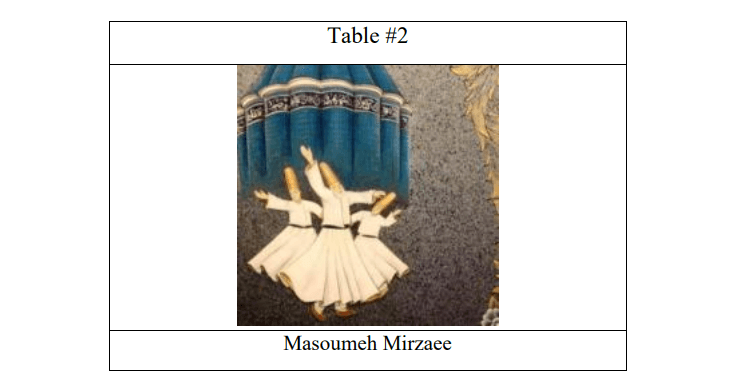
The inanimate nature, landscaping and figures are other subjects proceeded by early female painters in Afghanistan. Turpiki Nabizade got her MA in Tajikistan and is now a faculty member at the Faculty of Fine Arts at Herat University. (Table #3)
An Afghan female artist is not unconcerned about the environment she lives in. Most recent paintings reflect social issues and the artists' philosophic and human disturbances. Kandahar born Melina Solaiman graduated from Karachi Art Council founded Kandahar Fine Art Association (KFFA). Leila Mousavi is an Afghan artist living in Hamburg and Tahmina.
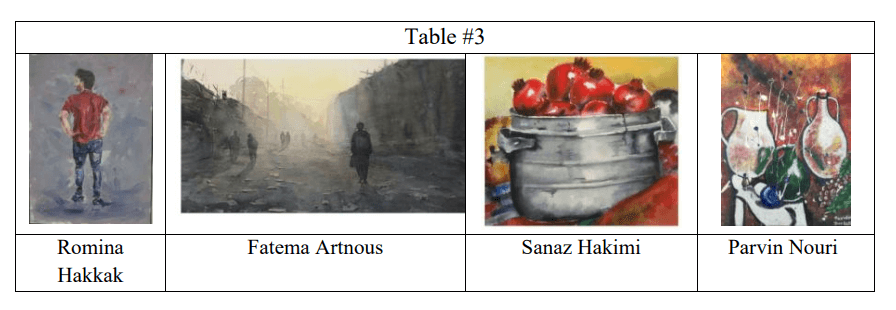
Tomyris is living in Gelsenkirchen – Germany. As a result of regarding the so-called subject "Afghan Woman", colours are more expressive in Tumiris's works; she also uses both realism and abstract to make the atmosphere in her works. Moshtari Helal uses traditional signs to criticise the attitudes related to women in Afghanistan. Most of her works are created by linear values. (Table #4)
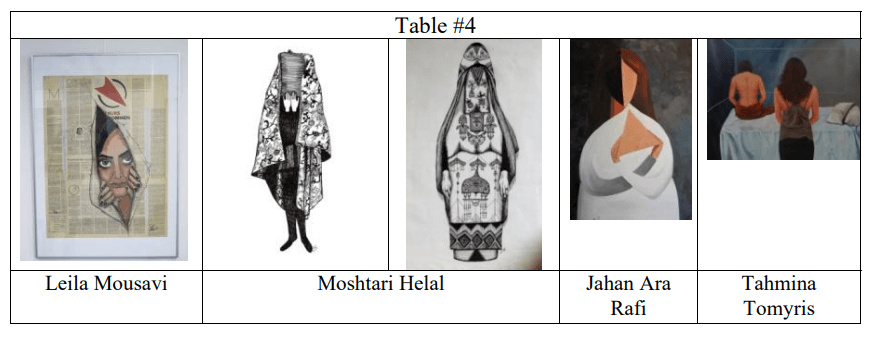
Portraits are one of the most repeated subjects in art, and they often depict the important political or religious characters or even regular people from different social classes.
Mirman Simin Shakur Vali is one of the pioneers among female painters in Afghanistan who has worked on this subject. Despite abstraction, naturalism also takes part in portraits painted by these women; because modernism has affected Afghanistan's contemporary art.

In 1932, Shakur Vali graduated from Art Montpellier – Paris and went to Kabul in 1943. Her portraits are more often oil paints. Most of Shamsieh Hassani's works, a graduate of sculpting and faculty member at Faculty of Fine Arts – Kabul University, are frescoes and graffiti. (Table #5)
Afghanistan's female painters' role in restoring Iranian Painting
Women have welcomed Painting in Afghanistan so much that there are more female students than male ones; Firuz Kuh Institute in Kabul is an example.
This institute currently includes six professors – two of them being MA graduate women and 32 students – 20 of them being female.
Also, there are more than four female professors teaching Painting at each of Herat and Kabul Fine Arts University faculties. According to sociologists' studies in 1396, women took part in arts in Herat more than in other cities. Women in Herat have been able to highlight themselves through their art; the misunderstandings about religion in Afghanistan are all due to their nonexistence in music, cinema and sculpting of this city, believes Ali Ahmad Kave, sociologist and professor at Herat University. On the other hand, Aliollah Azad, sociologist and professor at Herat University, declares that even though women's presence in art is bolder than before, it is still very marginal. (Azimi, 1396)
Since restoring Iranian Painting has always been an important subject for Afghanistan's contemporary artists, they have done many works about it in their galleries and biennials in Herat University.
Updating old techniques have succeeded at some point, as we can see the effects of geometry and colour variations in the artists' works. Akbar Khorasani, Abdunnasir Savabi and Navid Al-Haq Fazli are examples.
Also, we can see Iranian Painting elements in Khadem Ali, Behzad Saljouqi and Mohammad Homayoun Etemadi's artworks. (Table #6)
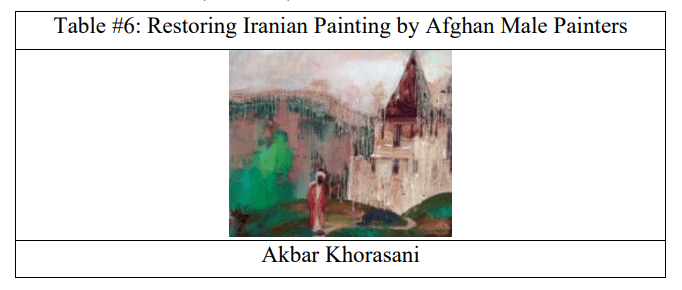
Afghan female painters have also succeeded in festivals and biennials, for example, Herat University Miniature Biennial.
Even though Afghan female painters have copied a lot of artworks for educational purposes, they have also done great activities about restoring Iranian Painting. Some of them have imported Iranian Painting elements into contemporary Painting, and others have achieved successes in form, concept and material.
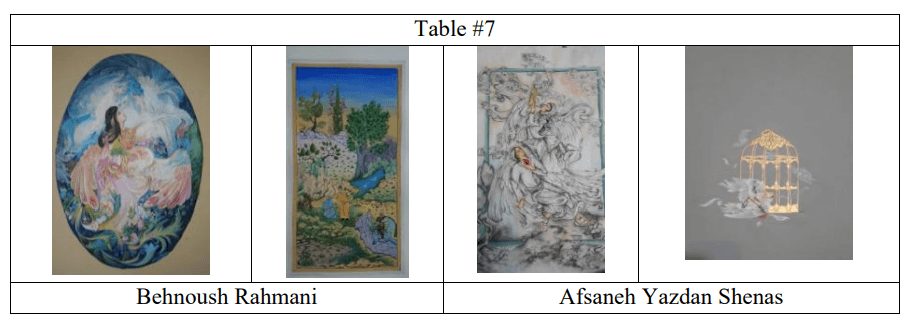
Afsaneh Yazdan Shenas and Behnoush Rahmani have created both classic and modern artworks. Yazdan Shenas is a painter from Herat and graduated in architecture in Iran, and Rahmani graduated from the Faculty of Fine Arts – Heart University. As we can see in their works, they have tried to modernize Iranian Painting's visual elements such as colour, gold colour, lines and particular surface uses. (Table #7)
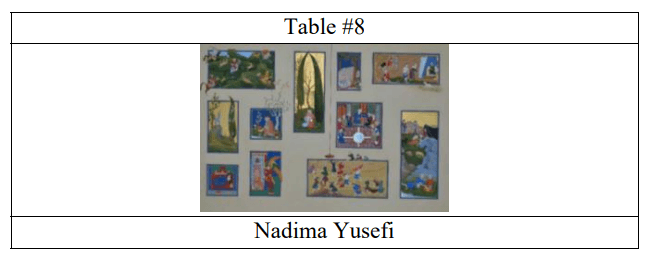
Nadima Yusefi is another prizewinning artist who tidily puts small artworks next to each other to create the final canvas; this makes her works unique. These trim pieces are Iranian Paintings, some of them being illuminations. In the example below, loops are combined with the flowers entering from the downside. This innovation shows a visual tradition in Iranian Painting imported to modern Painting, in which a part of the frame breaks. (Table #8)
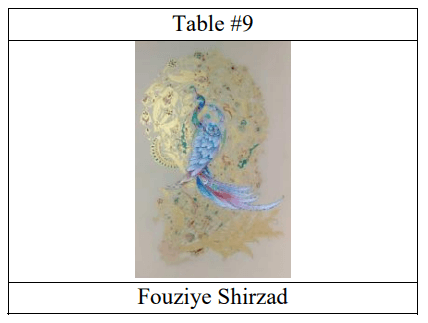
Some other artists are attracted to Farshchian's works, like Farida Sabouri (immigrant painter living in Florida) and Fouziye Shirzad (graduated from Herat University). These two artists have restored and fixed some Iranian Painting elements, including arabesques, lack of space, lack of western perspective, pure light without shadows and the use of gold colour in modern painting. (Table #9)
Adding elements like geometric designs, illumination and Tash'eer to modern Painting is another innovation in Afghanistan's contemporary art inspired by Iranian Painting. As an example, we can look at Ramzieh Askarzade's works. She is a graduate of Balkh University. One of her innovations is using calligraphy along with illustration and illumination. Najibeh Hosseini, bachelor of miniature at Herat University, does her works by modernizing composition and using geometric patterns and some cuts from Iranian Painting. In the example, we can see that she has limited all the composition to dots (golden circles), surfaces (frames), lines and patterns (background designs). (Table #10)
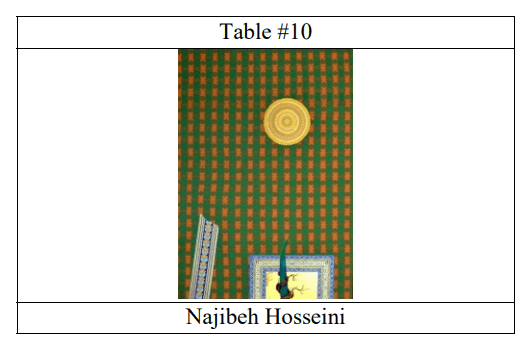
Sana Hasti, a painter from Herat, and Khatereh Hashemi, a painter from Kabul and manager at Baran School, have chosen to compose Painting, calligraphy and illumination to restore Iranian Painting. Banoo Sharifi has emphasized the composition of modern paintings in the background and herbaceous patterns inspired by Iranian Painting. Masoumeh Karimi has emphasized the herbaceous patterns and has tried to modernize the compositions and change the structure of the ways. Some other painters like Vajuma Shojaiee have endeavoured to depict feminine issues using Iranian Painting. (Table #11)
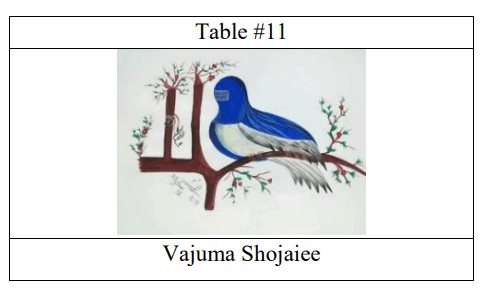
Saleha Wafa Javad, professor at Herat University – MA graduate, has restored the figure and landscaping technique in modern painting. Her works include illumination and fusion looping, but they also contain so many Iranian Painting techniques like colour, being shadow-free, colour harmony, and old-style landscaping. (Table #12)

Afghanistan has a deep connection with Shahnameh. "Shahnameh has referred to Zabolestan, Sistan and Nimruz 150 times; and Zabul, Hirmand, Kabulstan and Kabul 70 times, which all relate to Rostam's story." (Jafari, 1357: 316) Simorgh is one mythical creature that appears in Afghan paintings more often. For example, Helia Firouzi combines Simorgh with naturalistic Painting. Recent female artists have also painted a few modern artworks using oil and acrylic colours. They have tried to depict Islamic architectural patterns, flowers-and-birds, and Iranian painting figure techniques. Somayeh Hashemi, Shahedeh Shaygan and Monireh Mirzadeh are examples of this subject.
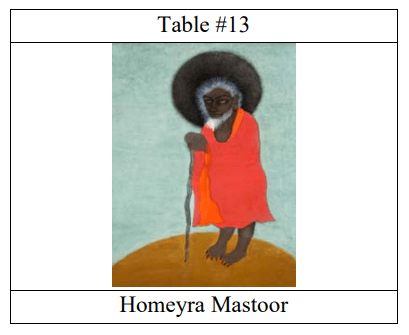
"Shirin's Look" (Negah-e-Shirin) is a self-portrait by Soghra Hosseini in which a part of the face is covered with a smiley face. The second picture depicts a bazar. Homeyra Mastoor painted a devil wearing red clothing, with a dark halo and holding a cane in his hand. Women are dancing in Hanife Jafari's artwork, and Zahra Bagheri has tried to show a paradisiacal image of taking water from the river. (Table #13)
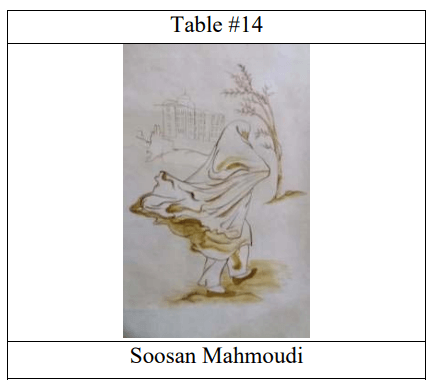
Drawing is another field in which women have taken part in trying to restore Iranian Painting elements. As we can see in Soosan Mahmoudi's works, realism and Iranian Painting techniques, in the way clothes have wrinkled, have provided an acceptable fusion artwork. Ramzieh Askarzade is another example that utilizes modern and naturalistic shadows and portraits using a pencil. Farkhondeh Mohammadi, a graduate of Herat University, combines monochrome with geometric patterns. (Table #14)
Conclusion
Afghanistan has a glorious history in art, literature and theosophy. All of the art documents and artists have grown in this land, proving the richness of the visual resources of this country. Thus, learning from the past is not only a step back for recent Afghan artists, but also is a motive in making new artworks. Women participating in art more than before is an outcome of modernism affecting Afghan contemporary art. Women have now started to paint portraits, landscapes, figures, inanimate nature or formalistic artworks on their canvases or the walls about political and feminine issues. Besides, these women have used the hereditary elements in their works to improve modern Painting in their country. The results of this study about Afghan female painters' role in restoring Iranian Painting can be summarized in six parts:
It seems like Afghanistan's female painters have more concentrated on two political-social methods to state their thoughts and feminine issues and restore Iranian Painting, which is a restoration of the visual inheritances of this country.
References